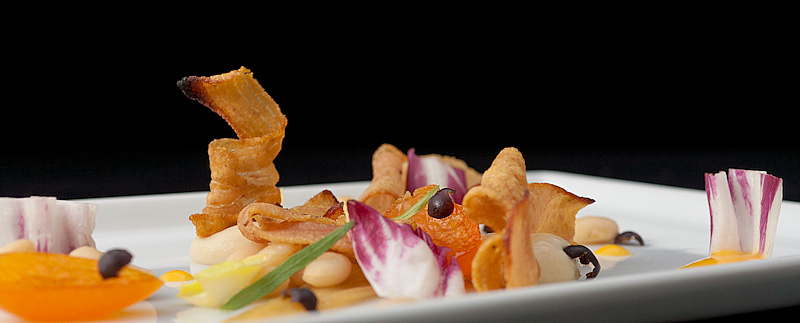
Bacon is as uncomplicated to make as it is to stuff rampantly down one’s gullet: a cut of pork (usually the belly in the US, called “streaky bacon” in European countries–including New Zealand–where leaner side or back cuts are preferred) is cured or brined in a concentrated solution of salt and other flavorings. After the brining process, bacon can be sliced and cooked directly, or (as is more common in the US) smoked before slicing for further flavor. Making one’s own bacon at home is actually fairly-straighforward; it’s one of the simplest recipes noted in the Charcuterie book.
Why not apply this process to other cuts of meat? This dish is built around exactly that: a fatty cut of fish is cured with salt and other flavorings, sliced thinly, and pan-fried to delicious crispness. The relative lightness of the protein is complimented with equally-light accompaniments: braised white beans, braised endive, radicchio, candied kumquats, orange sauce, tarragon, and juniper.
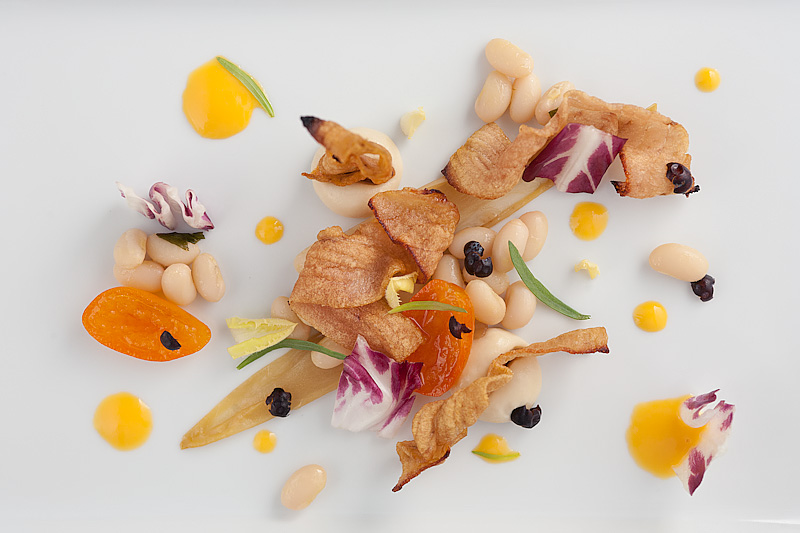
I started with the white bean puree, which meant soaking some dried great northern white beans overnight.
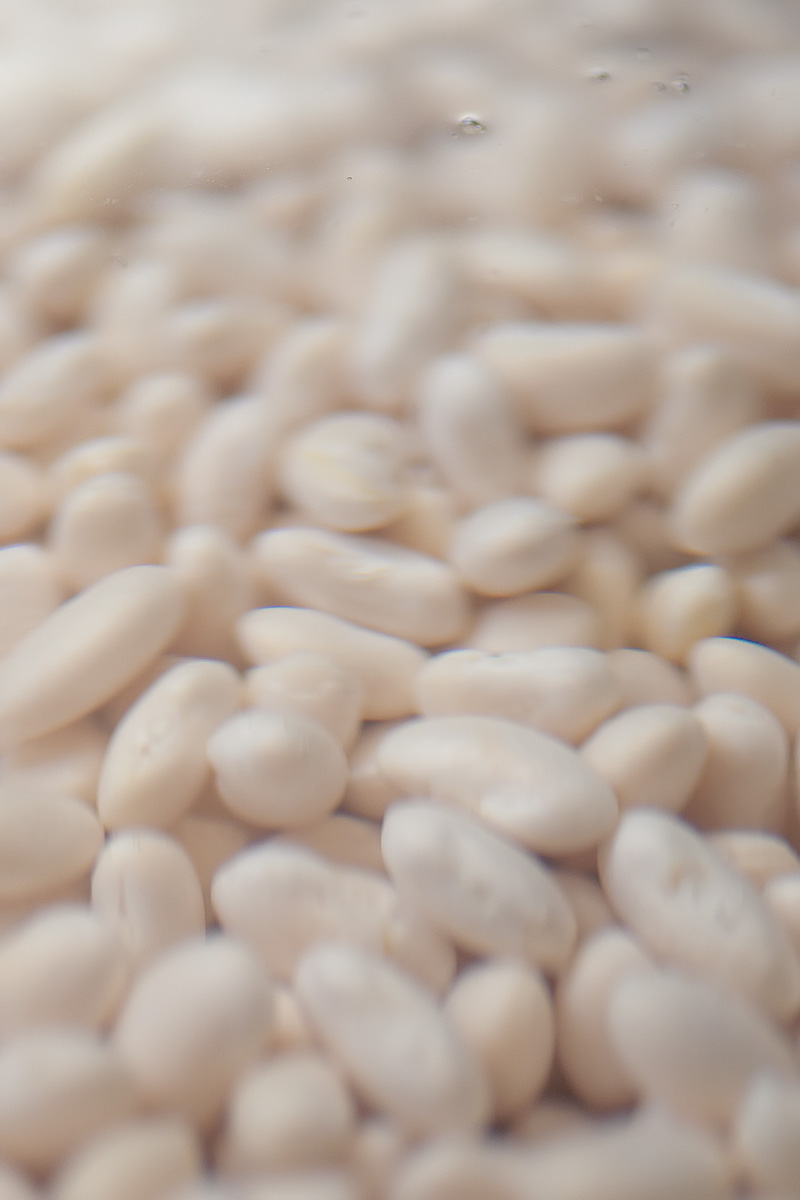
The next morning, I packed the beans in two vacuum bags along with juniper berries, olive oil, rosemary, and some butter. These were cooked en sous vide for several hours, until they were tender enough to smoosh with my fingers.
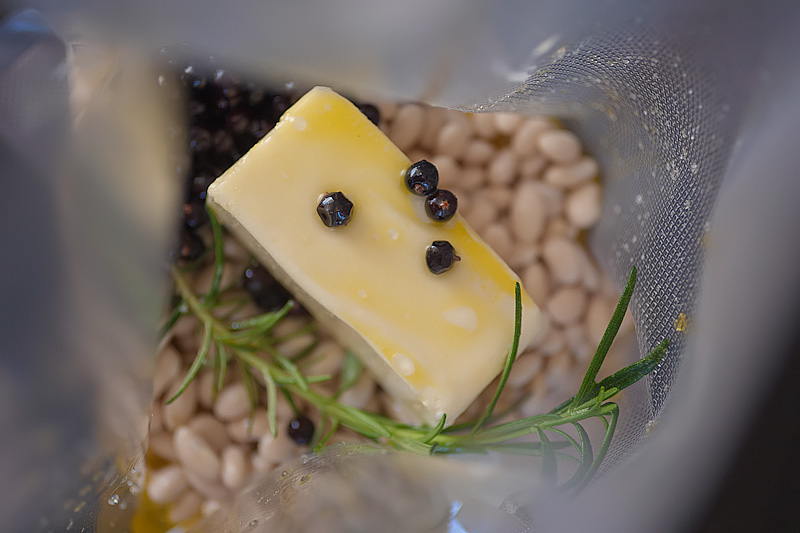
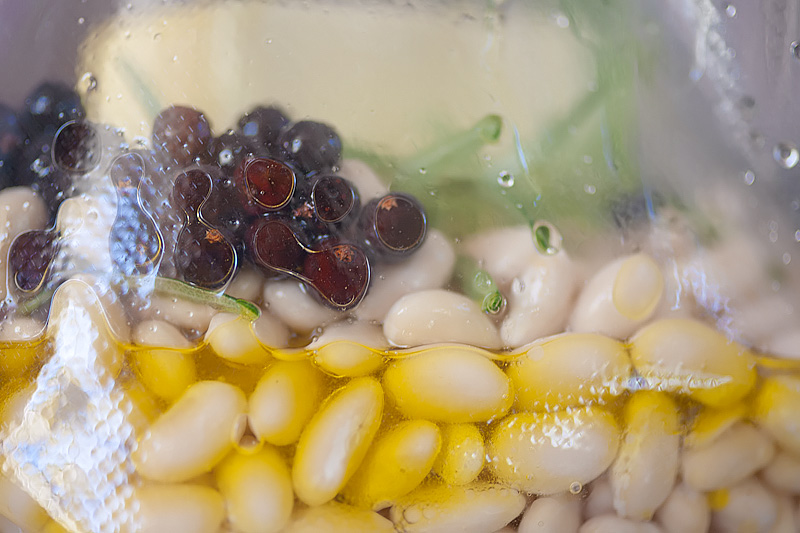
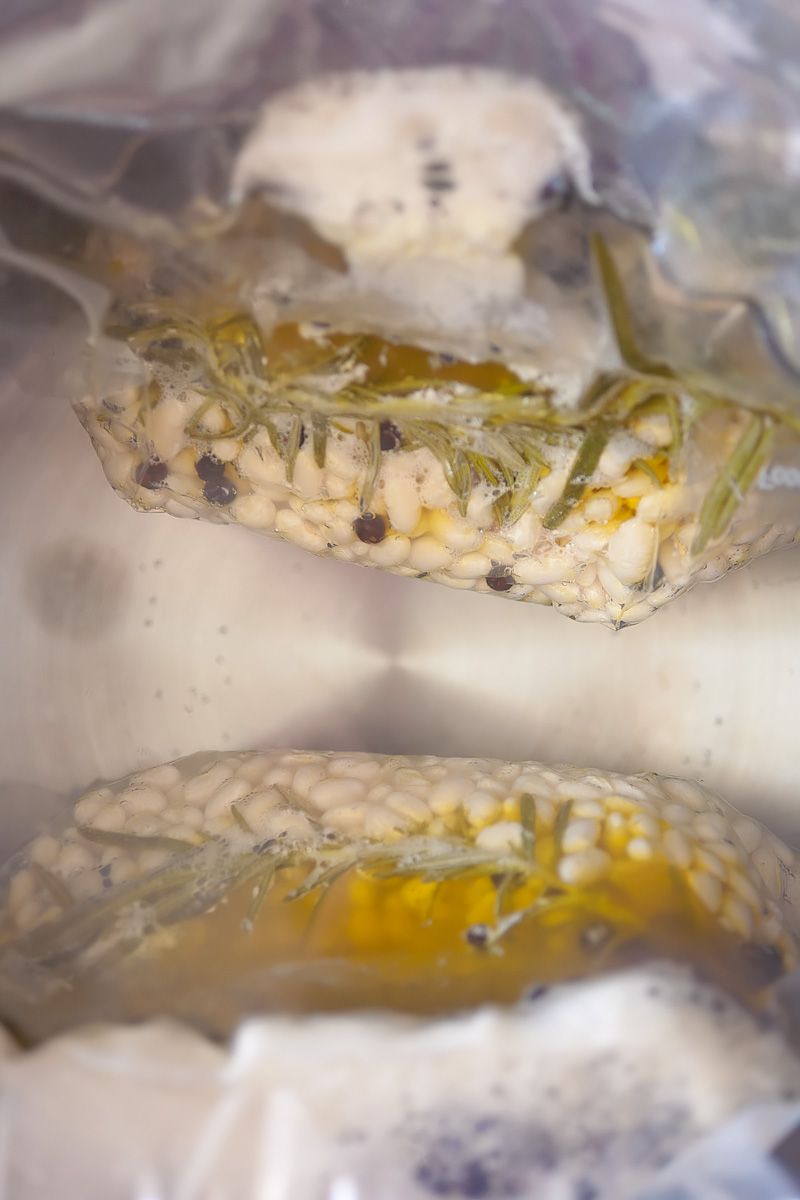
After cooking, I strained out the braising liquid into a container. The Alinea book doesn’t mention the need to separate out the juniper berries and rosemary sprig/leaves, which I did to help yield a perfectly smooth puree without any gritty bits (a mistake I’d made once before when making white bean puree).
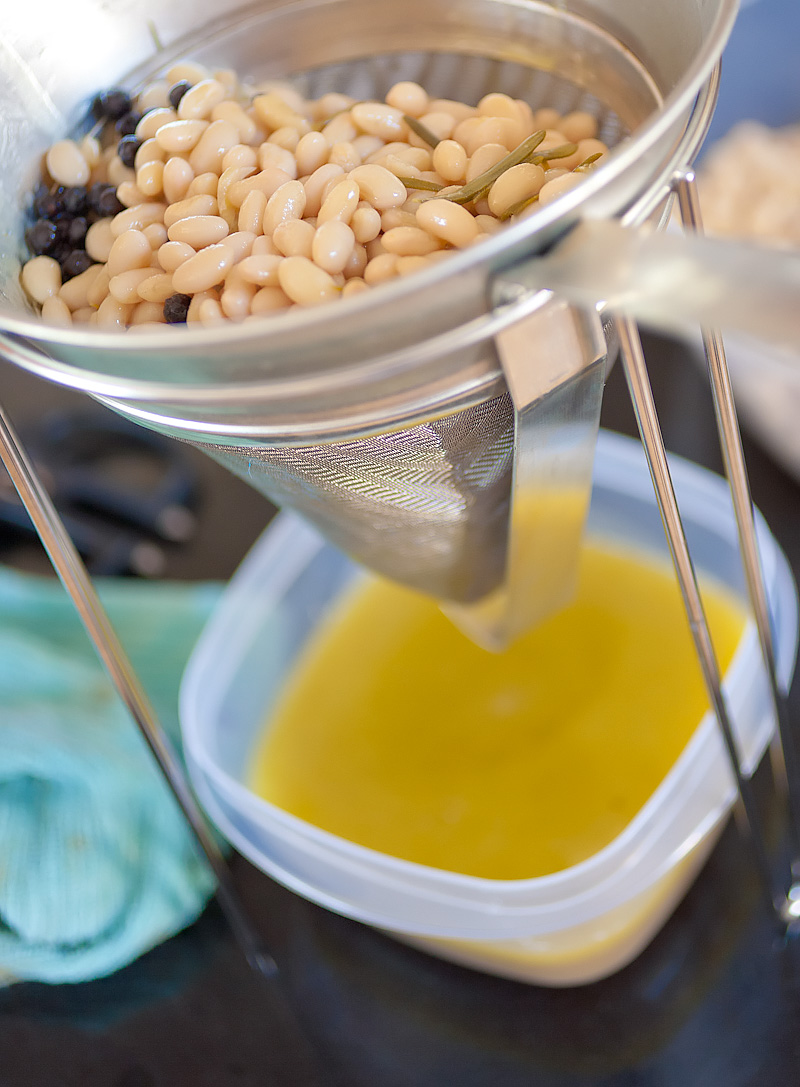
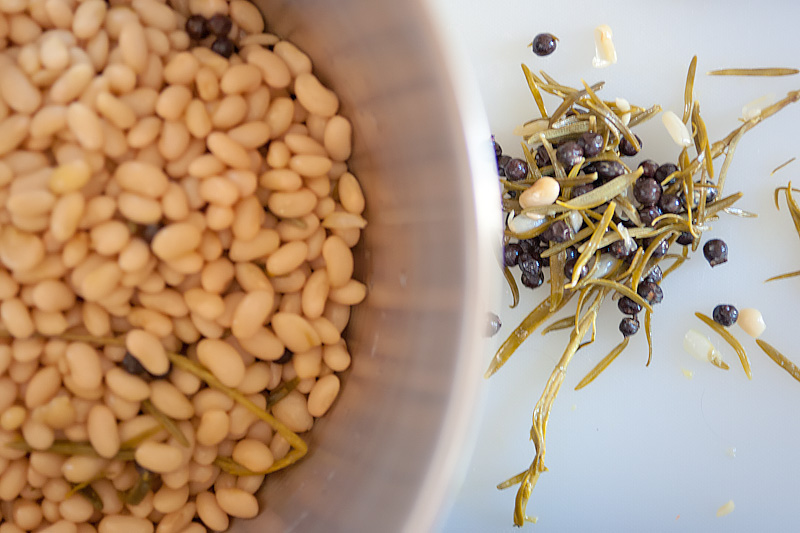
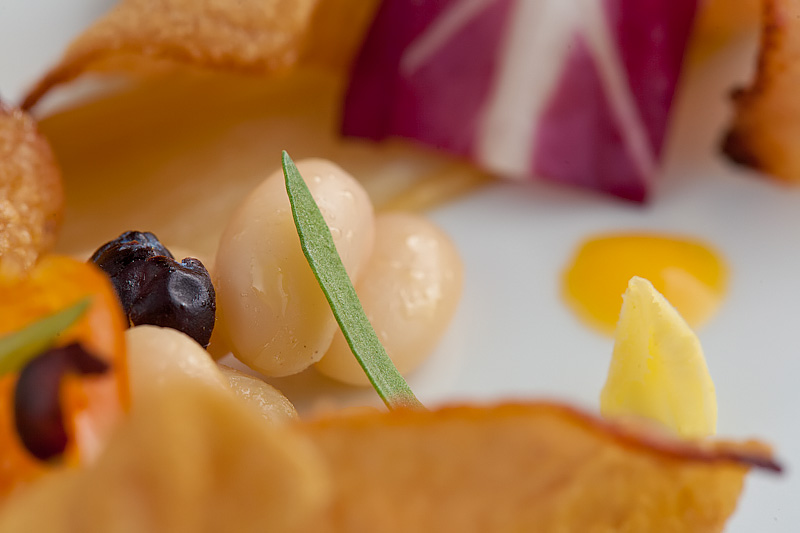
The recipe instructs me to combine some of the beans with what seemed like an enormous amount of salt, and blend on high speed for 8 minutes. I find I’ve developed a small but decently-reliable gut reaction to things that don’t seem exactly right, and rather than trying to google around for cookbook errata or corrections, I tend to slow down and creep up on the thing in question…in this case, the salt and the mixing time. I’ve oversalted stuff enough times to know when an amount seems really big, so I just seasoned the puree to taste and left it at that. But I was curious about the super-long mixing time, so I pushed it a bit.
White beans, like potatoes, rice, wheat and other starchy foods, are comprised of cells filled with…well, starch. If the integrity of the cells fails, the starch leaks out; this is bad news because starch has adhesive properties (starch is quite literally the main adhesive in most paper-use glues…like wallpaper paste). If you’ve ever had gummy mashed potatoes or sticky rice, you’ve experienced this phenomenon. Overcooked potatoes (which produce too-weak cell walls, which give way easily when agitated) or potatoes whipped with a hand mixer at high speed (which ruptures the cells) often yield sticky potatoes. I was a little curious if something similar would happen with the beans, and sure enough:
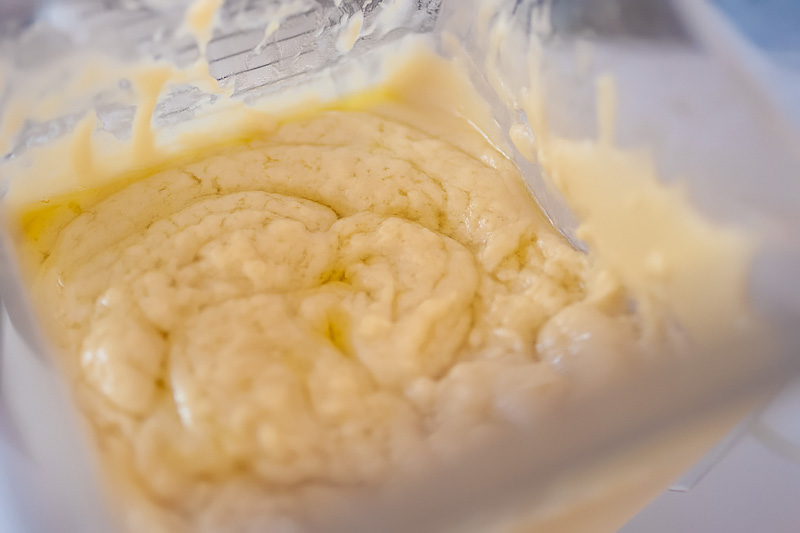
The bean puree turned gummy, and in turn separated from the oil that I’d blended into the mixture, yielding something looking like a broken mayonnaise. It was also extremely glue-y. After a lot of scrubbing to clean out my blender pot, I started again, the second time being careful cut off the blending just when things seemed nice and smooth. It tasted great; junipery and herbaceous and buttery and warm.
The next few steps involved working with citrus, and because I like drinking beer, I decided to try this one:
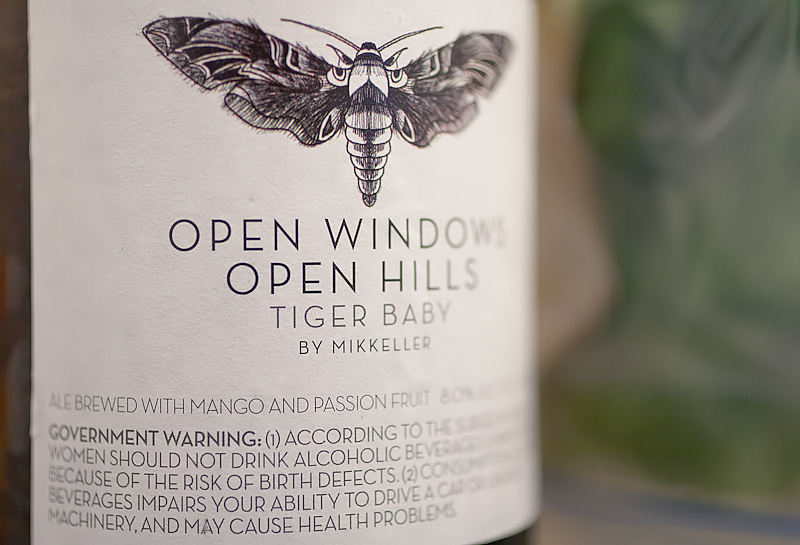
It was interesting in that it a) had nice subtle tropical fruit notes, and b) had ‘something else’ that I’ve tasted in my homebrew beer adventures before. Either this means my homebrew beers aren’t as mediocre as I thought, or this beer is more mediocre than Mikkeller usually offers. I’m not sure which one I want to believe more.
At any rate, on to making orange sauce. I started by quartering some oranges and cooking them en sous vide for several more hours. Berkeley Bowl had a nice big batch of Cara Red oranges when I visited last week, so i decided to try them. They have a nice grapefruity-orange tart flavor and a really pretty color.
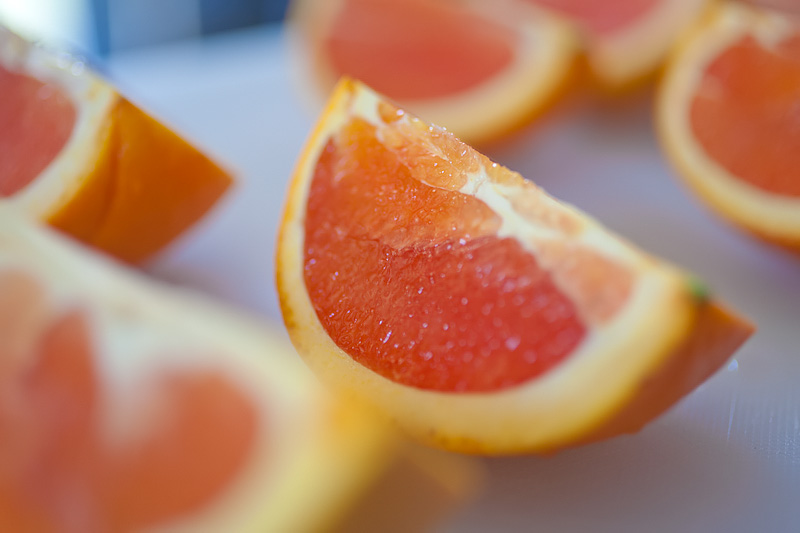
A past dish I’ve made from this book involved pureeing some oranges straight-up in a blender (without any cooking). Doing this yields a nice puree, but when I refrigerated it the rind seemed to settle and form an incredibly firm plug in my squeeze bottle–so firm I had to throw the whole thing away. I wasn’t quite sure what I did wrong, but I was nervous that I’d end up with something similar here. It turned out, though, that the cooking process causes something to happen such that the final puree stays liquid when refrigerated. The texture after blending was a little chunky, but the recipe goes on to instruct me to mix the puree with some orange juice to smooth things out.
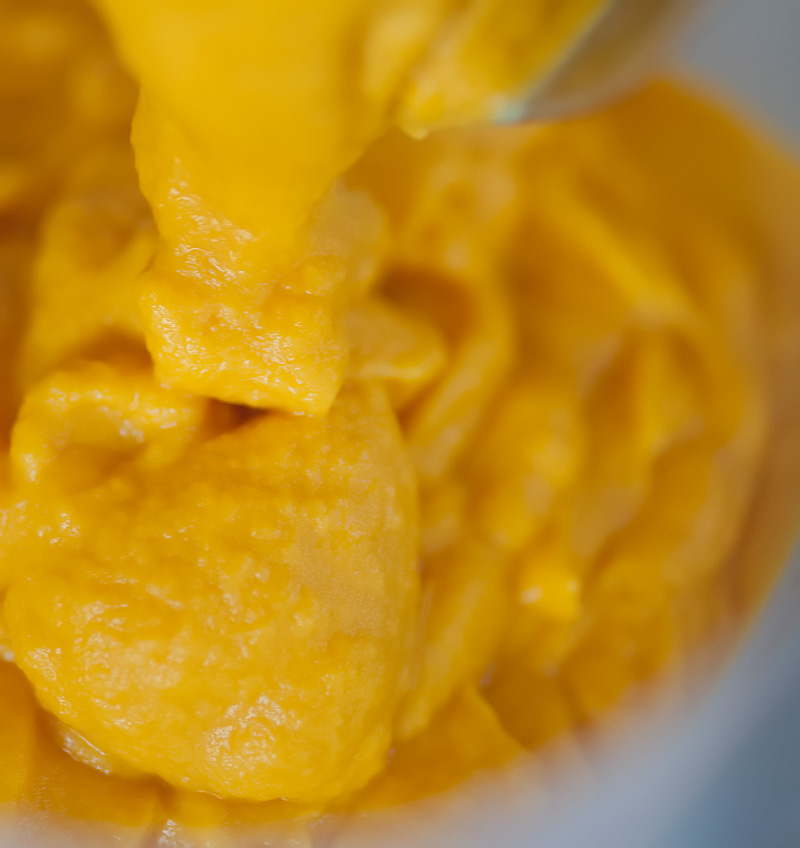
Next I braised some belgian endive leaves in a mixture of white wine vinegar, shallot, and juniper. I did a mix of red and white endives only because I really liked the leaves of the red ones and thought they might look nice. The final braised leaves tasted amazing but were incredibly delicate; they tore easily, which made plating a little rough.
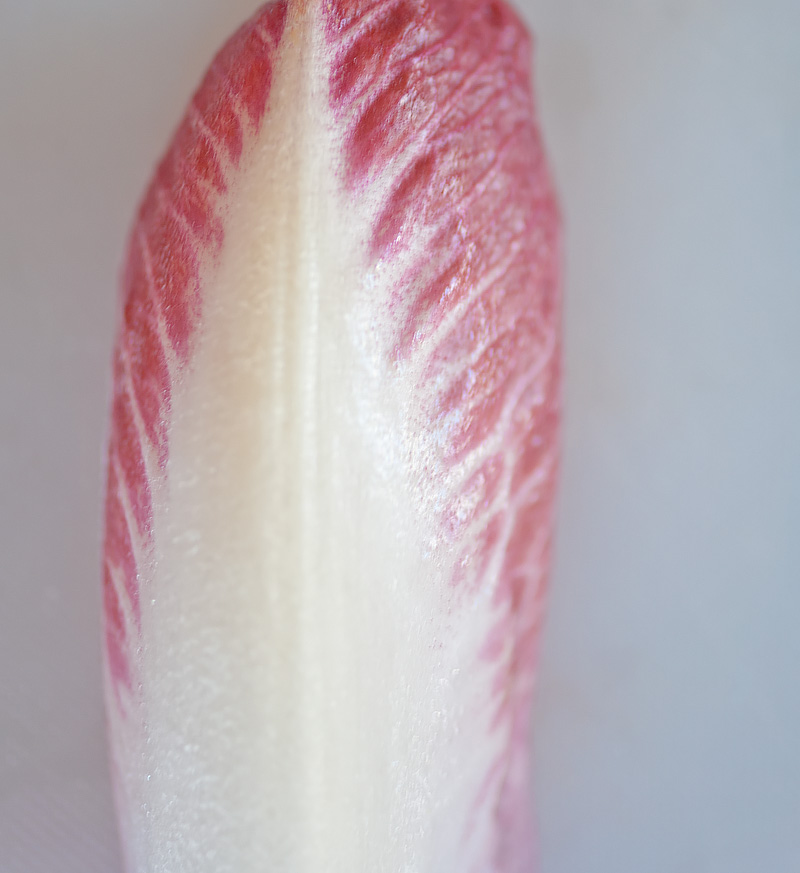
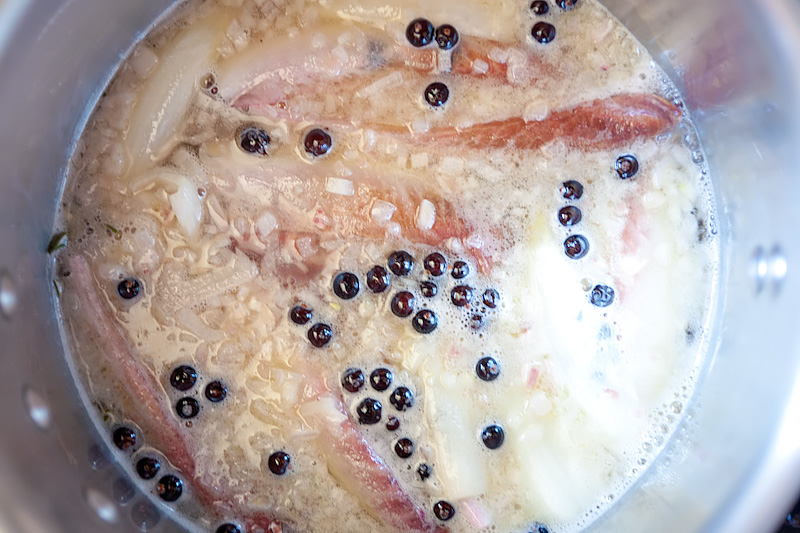
Finally, the fish. I started with a few loin slices of Opah, a tropical fish that–in winter months–is particularly tasty due to its increased fat marbling. I found this at Berkeley Bowl, and got help form the butcher in selecting some nicely-marbled cuts. These were brined for several hours in a mixture of water, salt, honey, and juniper: our “fish bacon cure”.
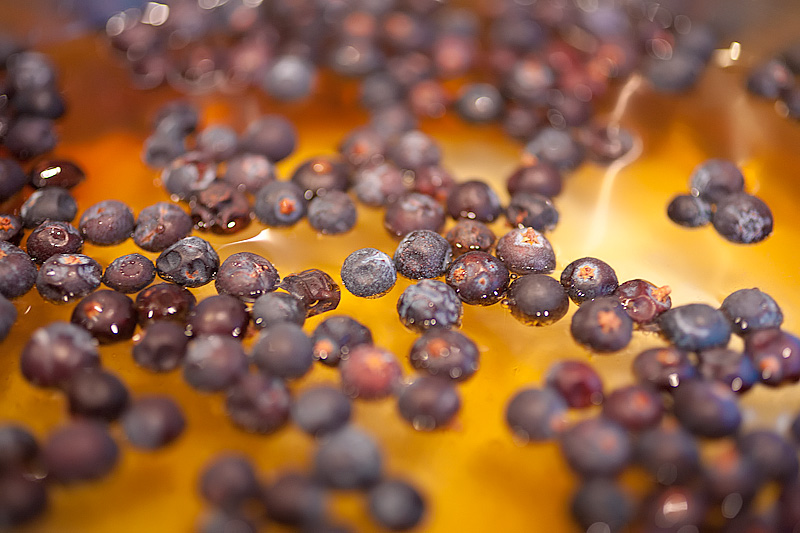
The fish was then removed, rinsed, and frozen overnight until it was firm enough to slice on…TA DA! A (borrowed) meat slicer! A friend from work owns this and loaned it to me for this dish. Two slices into it, Sarah asked skeptically “So…how is it?”
“TOTALLY AWESOME I WANT ONE!”
“Great.”
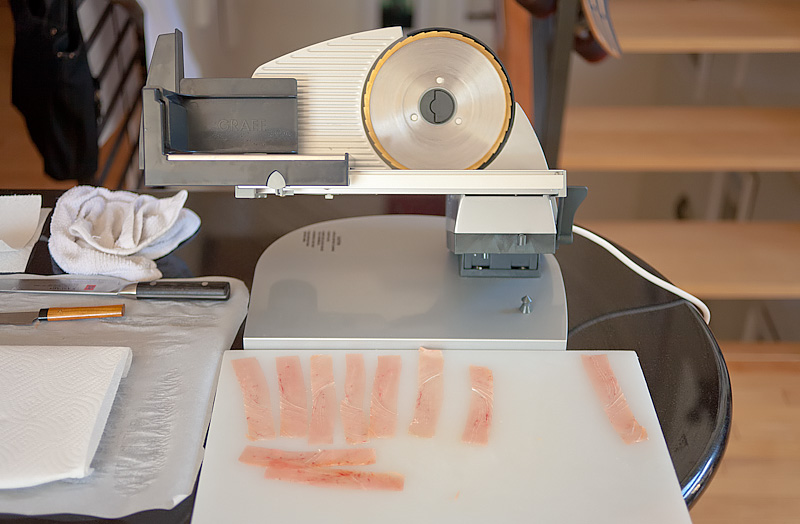
Honestly, there’s no substitute. I’ve always used a knife for this kind of stuff historically, being opposed by proxy to buying my own meat slicer. But…right tool for the job and all.
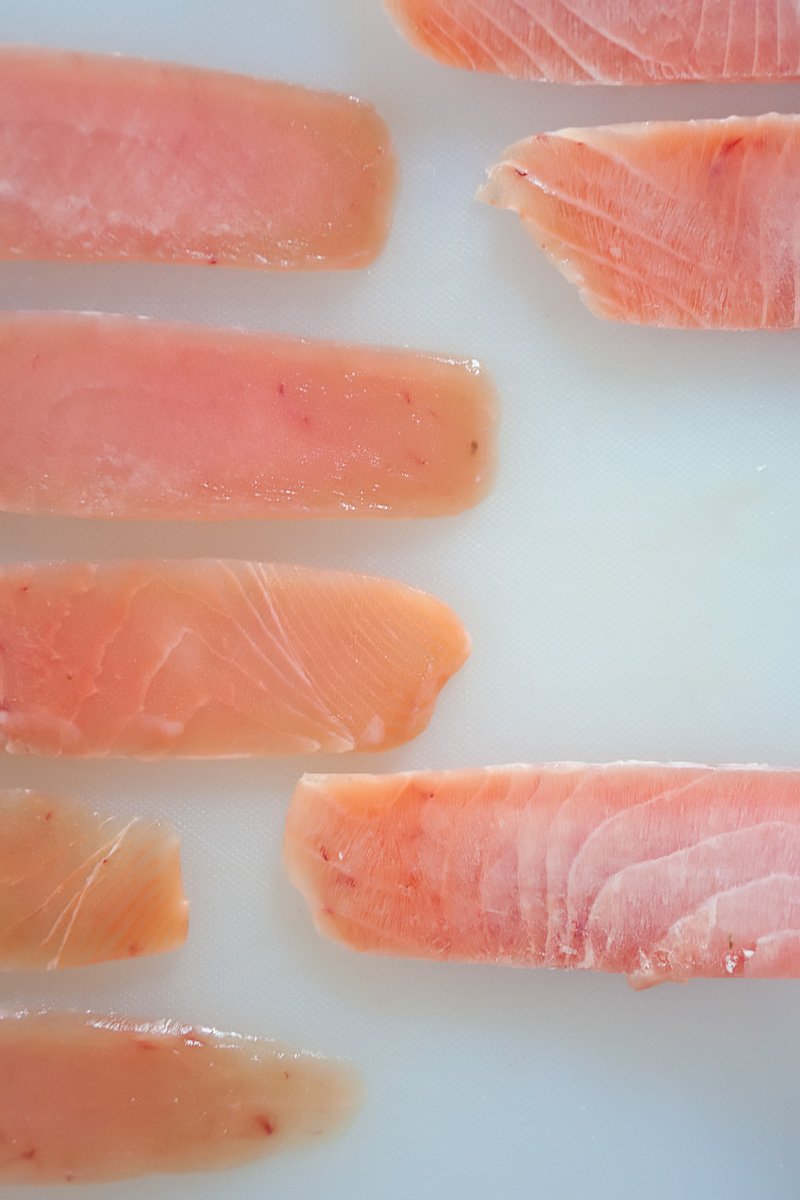
The recipe directs me to slice the fish into 1/8″ slices. This is thick-sliced bacon country. I tried a few of these, and fried them in a pan with some canola oil (the fish, despite being fatty, still carries way less fat than bacon, so I needed to augment this with some oil to help the frying process along).
Honestly I didn’t really love the thickness of that slice; it didn’t curl up in a visually-interesting way, and it had enough body to sort of taste like, well, thick dry fish. I tried slicing several more portions, each progressively-smaller. The last was as thin as a slice of prosciutto. I fried all of these to compare:
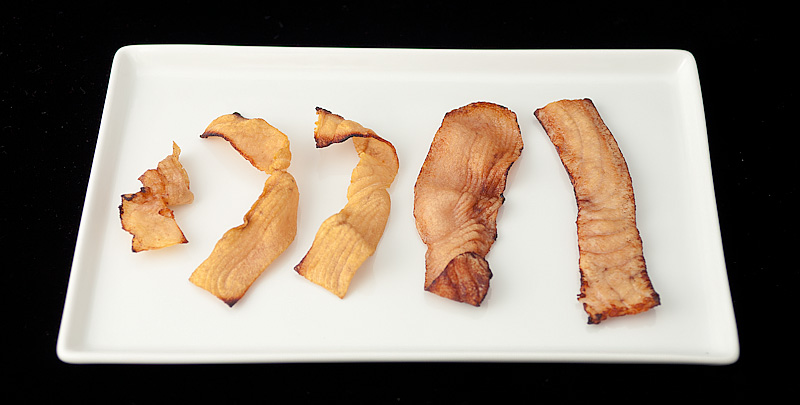
The thicker slices had more body, but the thin ones were incredibly crispy. It was a funny moment for me to realize that this is sort of like the deal with real bacon: everyone’s ideal bacon slice is different. My dad’s bacon was always shatteringly crisp when he cooked it on Sunday mornings, and the way he taught me to cook it is still the way I do so. Sarah likes hers a little thicker and floppier and less crispy. In the end, I aimed for the middle ground; still crisp enough to hold its shape, but not so thin as to be more like a potato chip than a slice of meat.
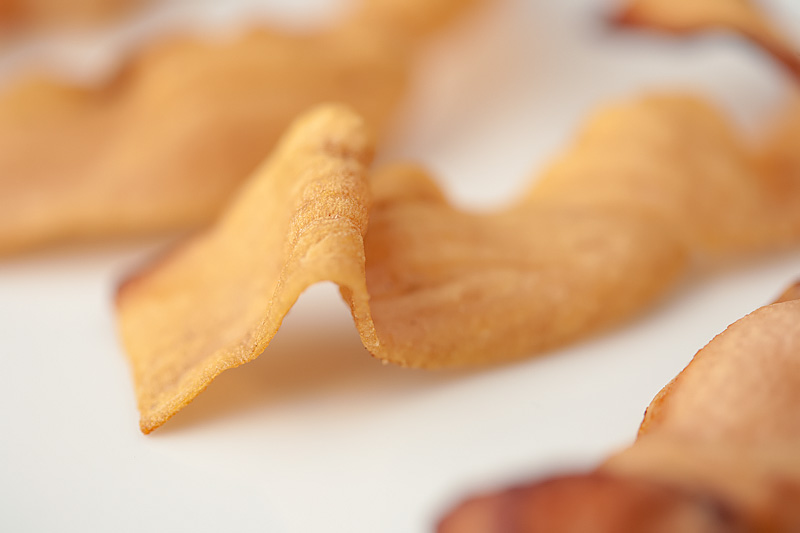
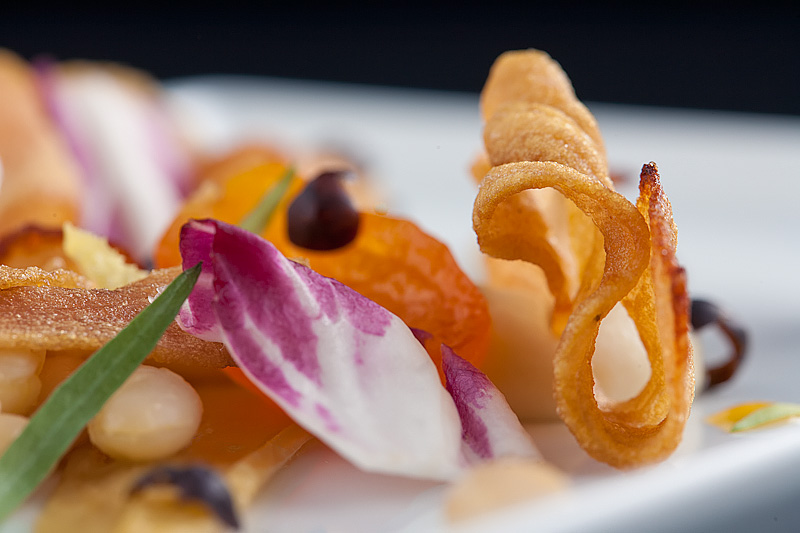
While the bacon was draining, I picked a few fresh tarragon leaves, and left them in ice water for a few minutes before plating.

When I plated everything and tasted it, my first reaction was “Neat!” The fish flavor is definitely present, but not overtly-so. Smoking the fish (in the US style of bacon) would overwhelm the subtle flavors imparted by the brining process, though I bet a bit of smoked salt wouldn’t hurt anything. I used the crispy bacon slices almost like utensils, scooping up various mouthfuls of the white beans, orange sauce, cooked kumquats, and tarragon sprigs to taste together. The flavors all work really well, and while I was a little worried that this is supposedly a Winter dish and that it would taste too heavy for the first warm days of spring we’re having in the bay area, it didn’t at all. It struck that amazing middle ground that Alinea seems to effortlessly be able to hit: something that’s delicious and bursting with flavor without being heavy and filling and ‘slow’. This is bright and peppy and leaves one ready for what’s next, which is what I’m on to now…
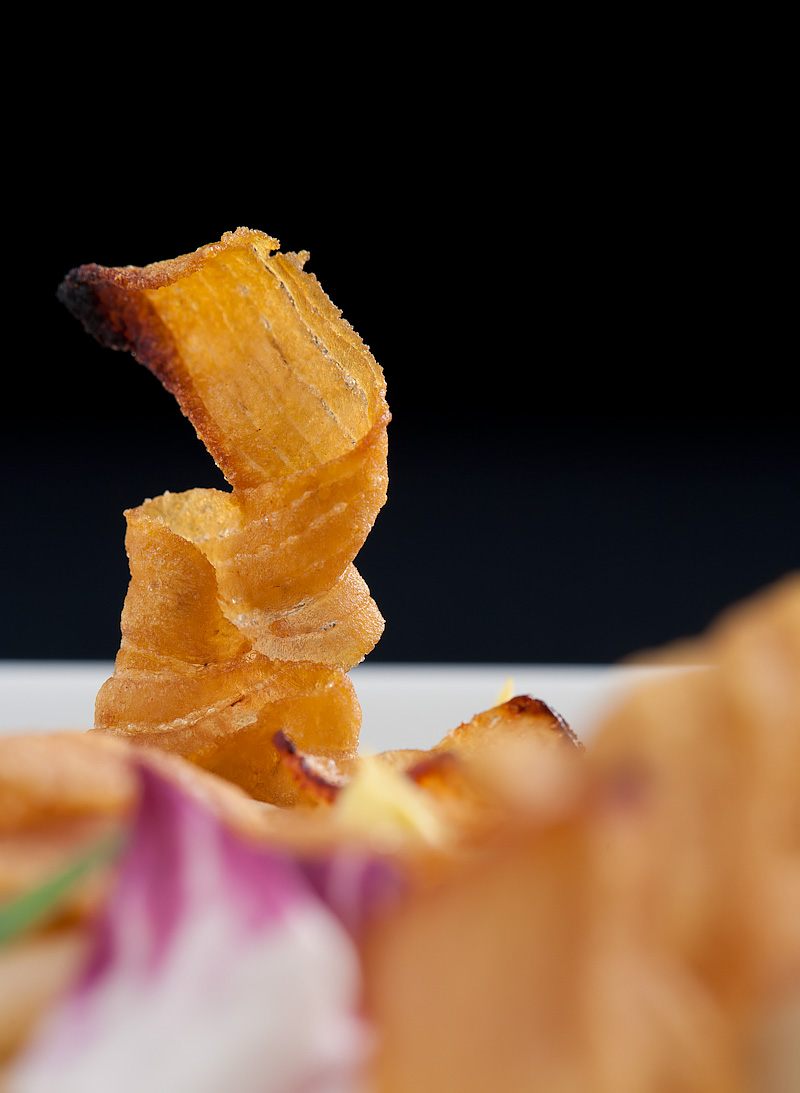
Fish bacon! That’s so cool.
Out of curiosity, are beans cooked en sous vide any different (better) than they are cooked more conventionally? With all of the flavouring agents sealed in with the beans instead of leaching out into the cooking liquid, it just seems like they might fare better. Beans are an important part of the grad student diet, which, of course, means that buying sous vide apparatus to cook them in is crazy talk. Still, I’m curious.
Hey Katie!
I’m not really sure about ‘better’; the other times I’ve cooked beans are in the context of making baked beans, so all the flavors sorta get mooshed together anyway. They certainly were extremely flavorful and, um, ‘clean’-tasting…by which I mean the flavors shone through brightly. Though, I will say: every time I’ve made beans starting with dried beans, the cooked beans have a lot of tooth (sorta like tender peanuts…not at all like canned beans). I don’t know if this is what I should expect? This happened both with traditional cooking and with the sous vide style.
Also! A friend borrowed my sous vide setup, so I did this super-ghetto style. I have a big stockpot (20qt, something like $14 from a drugstore) that I fill with water and hit with high heat until it reaches 190F (the temp for these beans), then turned the burner way down to maintain it. The bigger the body of water you’re working with, the slower the temperature drift, so it’s actually remarkably easy to control, especially for a home chef who’s not too fussed about a +-1 or 2 degree temp change, and especially with beans, which don’t need to be THAT precisely-controlled). You don’t really even need a vacuum sealer; just get a freezer bag and use that….you just don’t want a lot of air in the bag. I dip the bags in a filled sink to let the water pressure help push out air before sealing it up. Then put them in the pot and use the lid or a clothespin or something to keep them off the bottom (so the burner doesn’t melt the bag). Toss in a few ice cubes if you need to pull down the temperature suddenly, or crank up the heat to bring it back up. It’s kinda easy and fun. These beans cooked for about 4 hours or so like that; I just kept pulling the bag out with tongs and trying to smoosh one of the beans with my fingers to feel how tender they were getting.
Allen, I’m afraid to say that that’s not what you should expect from your beans, though it is a pretty common problem. Since you were pureeing your beans anyway, I guess it didn’t matter in this case. But generally, beans should be soft and velvety on the inside, like the canned ones. Sometimes, it’s just a matter of cooking them for longer, but the real problem is that the cheap beans at the grocery store are often really, really old and so never quite soften up properly. Since Octavian and I go through a lot of beans, we instead tend to order 8 or 10 pounds of beans from Rancho Gordo every 4-6 months. Their beans are fresh (that is, recently harvested and dried), carefully sourced, and come in lots of cool varieties. And since you live in the Bay Area, you can probably just find them at one of the farmers’ markets in San Francisco. Beans are kind of a mundane food, but using good beans makes a world of difference if you’re ever thinking of making something like cassoulet.
Thanks for the makeshift sous vide guidelines. I’ll have to try that sometime!